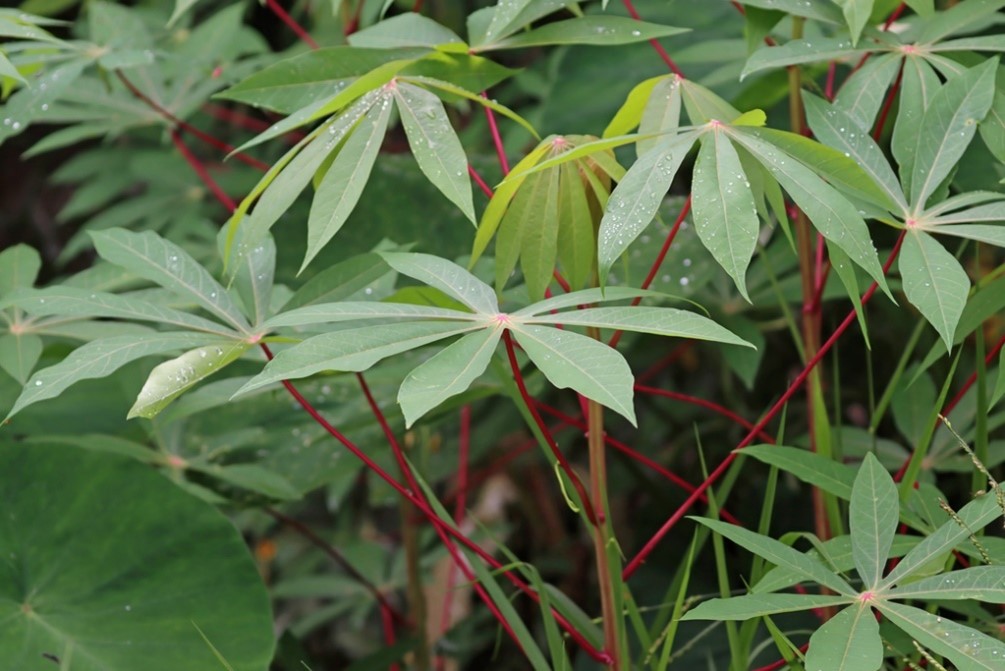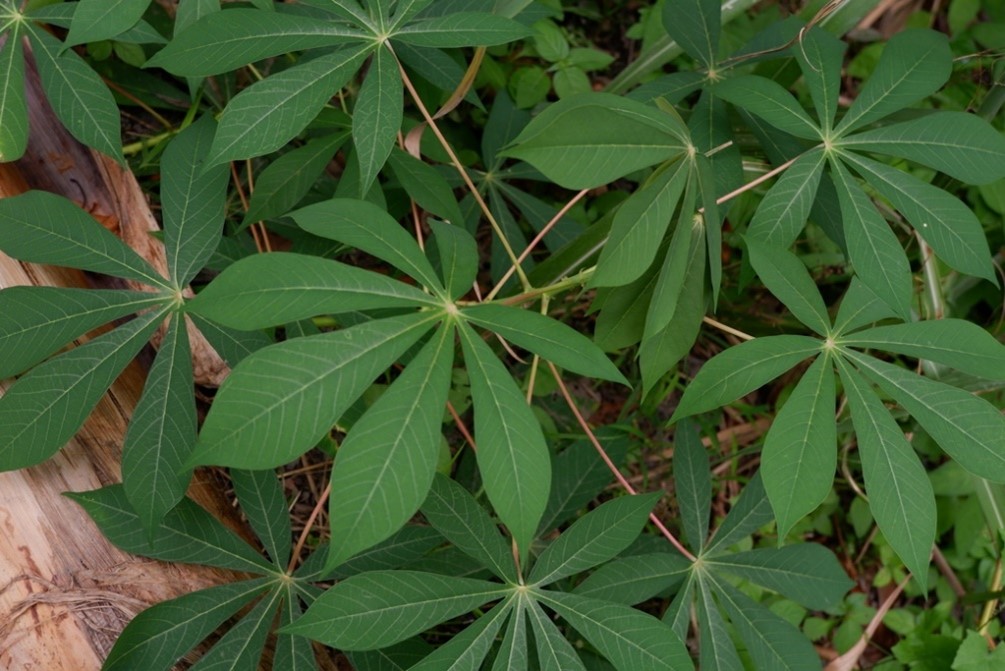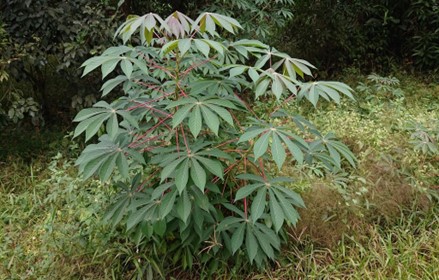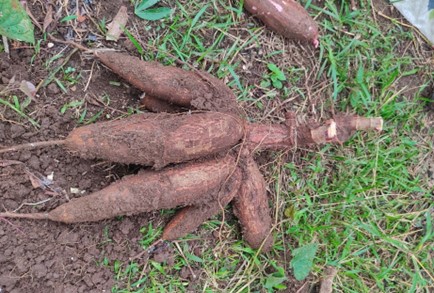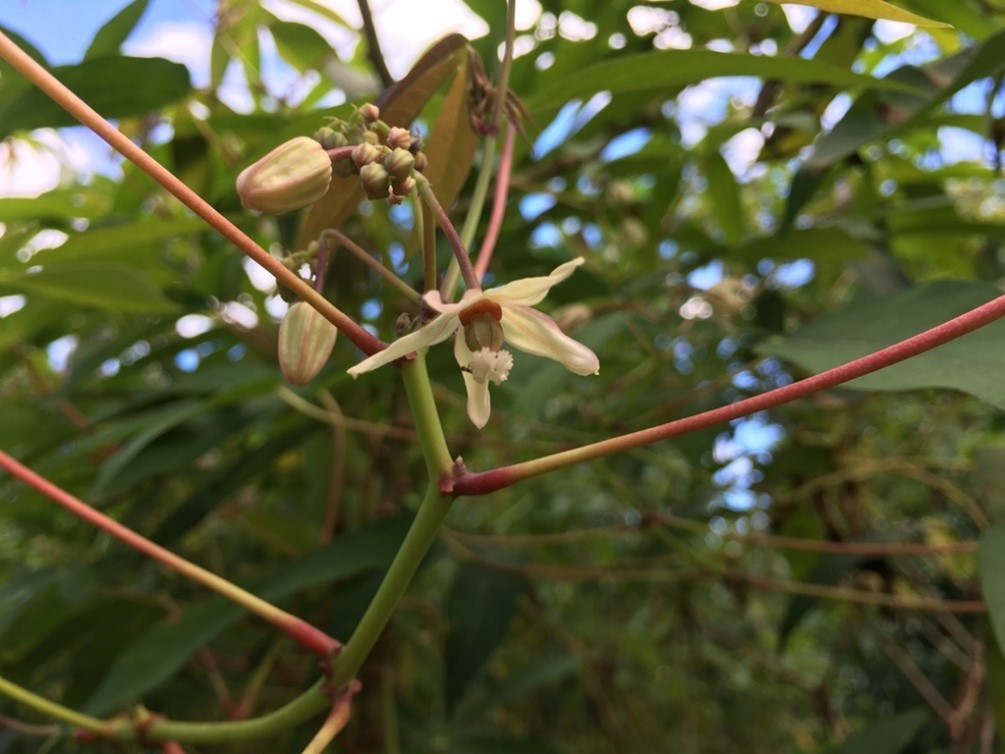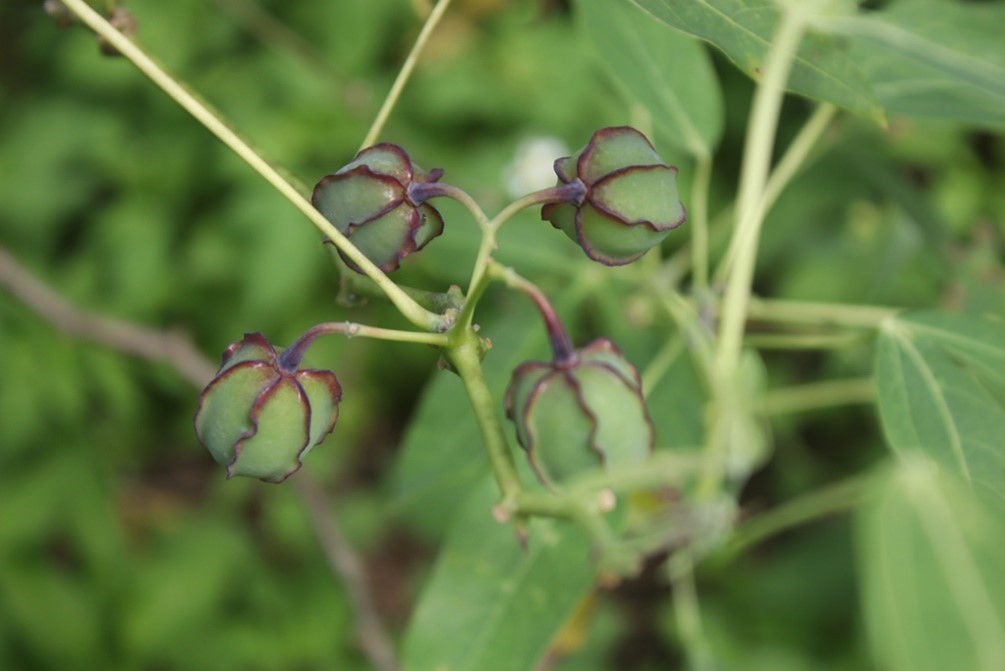ເລກລຳດັບທີ: 742
ລະດັບການຮວບຮວມຂໍ້ມູນ: ເກີອບສົມບູນ
ປັບປູງຄັ້ງລ່າສຸດ: 2025-02-11
ມັນຕົ້ນ
Cassava
Manihot esculenta Crantz
ພືດ
ໄມ້ຢືນຕົ້ນ
ໄມ້ພຸ່ມ
×
ຊື່ທ້ອງຖີ່ນ:
ມັນດ້າງ, ມັນກໍ ( Bitter Cassava, Manioc, Manioc Tapioca, Tapioca, Sweet Cassava, Cassava Manihot.)
ຊື່ພ້ອງ
:
Janipha aipi (Pohl) J.Presl
Janipha manihot (L.) Kunth
Jatropha aipi (Pohl) A.Moller
Jatropha aipi (Pohl) Göpp.
Jatropha diffusa (Pohl) Steud.
Jatropha digitiformis (Pohl) Steud.
Jatropha dulcis J.F.Gmel.
Jatropha flabellifolia (Pohl) Steud.
Jatropha glauca A.Rich.
Jatropha janipha Lour.
Jatropha lobata var. richardiana Müll.Arg.
Jatropha loureirii (Pohl) Steud., 1840
Jatropha loureiroi (Pohl) Steud.
Jatropha manihot L.
Jatropha mitis Rottb.
Jatropha mitis Sessé & Moc.
Jatropha paniculata Ruiz & Pav.
Jatropha paniculata Ruiz & Pav. ex Pax
Jatropha silvestris Vell.
Jatropha stipulata Vell.
Mandioca aipi (Pohl) Link
Mandioca dulcis (J.F.Gmel.) D.Parodi
Mandioca utilissima (Pohl) Link
Janipha manihot (L.) Kunth
Jatropha aipi (Pohl) A.Moller
Jatropha aipi (Pohl) Göpp.
Jatropha diffusa (Pohl) Steud.
Jatropha digitiformis (Pohl) Steud.
Jatropha dulcis J.F.Gmel.
Jatropha flabellifolia (Pohl) Steud.
Jatropha glauca A.Rich.
Jatropha janipha Lour.
Jatropha lobata var. richardiana Müll.Arg.
Jatropha loureirii (Pohl) Steud., 1840
Jatropha loureiroi (Pohl) Steud.
Jatropha manihot L.
Jatropha mitis Rottb.
Jatropha mitis Sessé & Moc.
Jatropha paniculata Ruiz & Pav.
Jatropha paniculata Ruiz & Pav. ex Pax
Jatropha silvestris Vell.
Jatropha stipulata Vell.
Mandioca aipi (Pohl) Link
Mandioca dulcis (J.F.Gmel.) D.Parodi
Mandioca utilissima (Pohl) Link
ຊື່ສະກຸນ:
Euphorbiaceae
ຊະນິດໃກ້ຄຽງ:
ເຍົາແດງ/ Coral bush
ຕົ້ນໝາກເຍົາເລືອດ / Bellyache Bush
ຕົ້ນໝາກເຍົາ / Bubble Bush
ຕົ້ນໝາກເຍົາເລືອດ / Bellyache Bush
ຕົ້ນໝາກເຍົາ / Bubble Bush
ບັນຍາຍລັກສະນະທາງພືດສາດ:
ຈັດເປັນໄມ້ຟຸ່ມ ໂດຍທົ່ວໄປຈະສູງ 1 ຫາ 4 ມ., ມີຮາກທີ່ໜາ ແລະ ແຂງແຮງ, ລຳຕົ້ນຕັ້ງຊື່, ຜິວລຽບ ແລະ ກົມເມື່ອຍັງນ້ອຍ, ເມື່ອລຳຕົ້ນຈະເລືອນເຕັມທີ່ຈະບວມຂື້ນ, ມີຮ່ອງຮອຍຂອງໃບທີ່ເດັ່ນຊັດ ແລະ ມີຫູໃບຂະໜາດນ້ອຍຕິດຢູ່.
ໃບແບບຝາມື ມີໃບຍ່ອຍແຍກອອກມາຈາກຈຸດດຽວກັນ, ກ້ານໃບຍາວ 3 ຫາ 20 ຊມ., ແຜ່ນໃບແຍກອອກເປັນ 3 ຫາ 10 ແສກ ຫຼື ອາດຈະບໍ່ແຍກອອກເປັນແສກ, ແສກກາງໃບຍາວ 5 ຫາ 18 ຊມ., ຂອບບາງ ແລະ ບໍ່ມ້ວນງໍ, ປາຍແຫຼມ, ຜິວລຽບ ຫຼື ມີຂົນອ່ອນປົກຄຸມ.
ຊໍ່ດອກແບບກະຈະ, ອອກຕາມກິ່ງກ້ານ, ຍາວ 2 ຫາ 10 ມ., ກ້ານດອກແຂງ ແລະ ຍາວ 2 ຫາ 4 ຊມ. ດອກຍ່ອຍມີເກສອນເພດແມ່ຍາວປະມານ 20 ມມ., ແລະ ເກສອນເພດຜູ້ 10 ອັນ.
ໝາກມີຄວາມຍາວປະມານ 1,5 ຊມ. ແກ່ນມີຂະໜາດນ້ອຍ, ຮູບກົມ ຫຼື ບ້ຽວເລັກນ້ອຍ ແລະ ຍາວປະມານ 12 ມມ.
ແຫຼ່ງທີ່ມາ: [1]
ຈັດເປັນໄມ້ຟຸ່ມ ສູງ 1,5 ຫາ 5 ມ., ມີຫົວໃຕ້ດິນຮູບຊົງກະບອກ ເຊິ່ງໃຫ້ຄວາມໝັ່ນຄົງ ແລະ ມິຄຸນຄ່າທາງດ້ານໂພຊະນາການ. ມີໃບປະດັບຂະໜາດນ້ອຍຢູ້ອຍໂຄນກ້ານໃບ, ຮຸູບສາມຫຼ່ຽມປົນຮູບຫອກ, ຍາວ 5 ຫາ 7 ມມ., ແລະ ອາກຈະລຽບ ຫຼື ມີຂົນແຂງ 1 ຫາ 2 ປ້ອງກໍ່ໄດ້.
ກ້ານໃບຍາວຕັ້ງແຕ່ 5 ຫາ 35 ຊມ., ແລະ ມີຮູບຮ່າງຄ້າຍຫຼອດ, ຫ່າງຈາກຂອບໃບປະມານ 5 ມມ. ໃບມີແສກຮູບຝາມື ໂດຍທົ່ວໄປມີ 3 ຫາ 9 ແສກ, ແລະ ມີຂະໜາດ 5 ຫາ 20 ຊມ., ຮູບຫອກປີ້ນ ຫາ ຮູບຮີແຄບ, ຍາວ 8 ຫາ 18 ຊມ., ແລະ ກວ້າງ 1,5 ຫາ 4 ຊມ.ປາຍແຫຼມ ແລະ ຂອບລຽບ.
ຊໍ່ດອກຮຽງກະຈະ, ອອກບໍລິເວນປາຍກິ່ງ ຫຼື ງ່າມໃບ ໂດຍຈະຍາວ 5 ຫາ 8 ຊມ. ໃບປະດັບຮູບຫອກຍາວຮີ. ກ້ານດອກຍາວ 4 ຫາ 6 ຊມ. ດອກເພດຜູ້ມີກບດອກຍາວປະມານ 7 ມມ., ແລະ ມີສີມ່ວງແດງ. ກາບດອກແບ່ງອອຫເປັນສອງສ່ວນ, ໂດບກີບດອກຍາວ ແລະ ເປັນຮູບໄຂ່ ໂດຍມີຂະໜາດ 3 ຫາ 4 ຄູນ 2,5 ມມ., ມີຂົນດ້ານໃນ, ແຕ່ລະດອກຈະມີເກສອນເພດຜູ້ຍາວ 6 ຫາ 7 ມມ. ແລະ ມີຖົງລະອອງເກສອນສີຂາວຈັບຢູ່ສ່ວນປາຍກ້ານ. ດອກເພດແມ່ຈະມີກາບດອກທີ່ໃຫຍ່ກ່ວາ, ຍາວປະມານ 10 ມມ., ກີບດອກຮູບຫອກ ຫຼື ຮູບຮີຍາວ, ຂະໜາດ 8 ຄູນ 3 ມມ., ເຕົ້າໄຂ່ຮູບໄຂ່, ແລະ ມີມຸມຕາມລວງຍາວ 6 ມຸມ ໂດຍປາຍຮວງຮັບຈະໂຄ່ງກັບ ແລະ ມີລັກສະນະສານກັນ.
ໝາກຮູບຮີ, ຍາວ 1,5 ຫາ 1,8 ຊມ., ກວ້າງ 1 ຫາ 1,5 ຊມ., ມີລັກສະນະເປັນປີກຕາມລວງຍາວ 6 ປີກ, ເນື້ອຍາບ. ແກ່ນຮູບສາມຫຼ່ຽມ, ຍາວປະມານ 1 ມມ., ເປືອກຫຸ້ມແກ່ນແຂງ ແລະ ລຽບ, ມີລາຍຈຸດຢູ່ທົ່ວ.
ແຫຼ່ງທີ່ມາ: [10]
ໃບແບບຝາມື ມີໃບຍ່ອຍແຍກອອກມາຈາກຈຸດດຽວກັນ, ກ້ານໃບຍາວ 3 ຫາ 20 ຊມ., ແຜ່ນໃບແຍກອອກເປັນ 3 ຫາ 10 ແສກ ຫຼື ອາດຈະບໍ່ແຍກອອກເປັນແສກ, ແສກກາງໃບຍາວ 5 ຫາ 18 ຊມ., ຂອບບາງ ແລະ ບໍ່ມ້ວນງໍ, ປາຍແຫຼມ, ຜິວລຽບ ຫຼື ມີຂົນອ່ອນປົກຄຸມ.
ຊໍ່ດອກແບບກະຈະ, ອອກຕາມກິ່ງກ້ານ, ຍາວ 2 ຫາ 10 ມ., ກ້ານດອກແຂງ ແລະ ຍາວ 2 ຫາ 4 ຊມ. ດອກຍ່ອຍມີເກສອນເພດແມ່ຍາວປະມານ 20 ມມ., ແລະ ເກສອນເພດຜູ້ 10 ອັນ.
ໝາກມີຄວາມຍາວປະມານ 1,5 ຊມ. ແກ່ນມີຂະໜາດນ້ອຍ, ຮູບກົມ ຫຼື ບ້ຽວເລັກນ້ອຍ ແລະ ຍາວປະມານ 12 ມມ.
ແຫຼ່ງທີ່ມາ: [1]
ຈັດເປັນໄມ້ຟຸ່ມ ສູງ 1,5 ຫາ 5 ມ., ມີຫົວໃຕ້ດິນຮູບຊົງກະບອກ ເຊິ່ງໃຫ້ຄວາມໝັ່ນຄົງ ແລະ ມິຄຸນຄ່າທາງດ້ານໂພຊະນາການ. ມີໃບປະດັບຂະໜາດນ້ອຍຢູ້ອຍໂຄນກ້ານໃບ, ຮຸູບສາມຫຼ່ຽມປົນຮູບຫອກ, ຍາວ 5 ຫາ 7 ມມ., ແລະ ອາກຈະລຽບ ຫຼື ມີຂົນແຂງ 1 ຫາ 2 ປ້ອງກໍ່ໄດ້.
ກ້ານໃບຍາວຕັ້ງແຕ່ 5 ຫາ 35 ຊມ., ແລະ ມີຮູບຮ່າງຄ້າຍຫຼອດ, ຫ່າງຈາກຂອບໃບປະມານ 5 ມມ. ໃບມີແສກຮູບຝາມື ໂດຍທົ່ວໄປມີ 3 ຫາ 9 ແສກ, ແລະ ມີຂະໜາດ 5 ຫາ 20 ຊມ., ຮູບຫອກປີ້ນ ຫາ ຮູບຮີແຄບ, ຍາວ 8 ຫາ 18 ຊມ., ແລະ ກວ້າງ 1,5 ຫາ 4 ຊມ.ປາຍແຫຼມ ແລະ ຂອບລຽບ.
ຊໍ່ດອກຮຽງກະຈະ, ອອກບໍລິເວນປາຍກິ່ງ ຫຼື ງ່າມໃບ ໂດຍຈະຍາວ 5 ຫາ 8 ຊມ. ໃບປະດັບຮູບຫອກຍາວຮີ. ກ້ານດອກຍາວ 4 ຫາ 6 ຊມ. ດອກເພດຜູ້ມີກບດອກຍາວປະມານ 7 ມມ., ແລະ ມີສີມ່ວງແດງ. ກາບດອກແບ່ງອອຫເປັນສອງສ່ວນ, ໂດບກີບດອກຍາວ ແລະ ເປັນຮູບໄຂ່ ໂດຍມີຂະໜາດ 3 ຫາ 4 ຄູນ 2,5 ມມ., ມີຂົນດ້ານໃນ, ແຕ່ລະດອກຈະມີເກສອນເພດຜູ້ຍາວ 6 ຫາ 7 ມມ. ແລະ ມີຖົງລະອອງເກສອນສີຂາວຈັບຢູ່ສ່ວນປາຍກ້ານ. ດອກເພດແມ່ຈະມີກາບດອກທີ່ໃຫຍ່ກ່ວາ, ຍາວປະມານ 10 ມມ., ກີບດອກຮູບຫອກ ຫຼື ຮູບຮີຍາວ, ຂະໜາດ 8 ຄູນ 3 ມມ., ເຕົ້າໄຂ່ຮູບໄຂ່, ແລະ ມີມຸມຕາມລວງຍາວ 6 ມຸມ ໂດຍປາຍຮວງຮັບຈະໂຄ່ງກັບ ແລະ ມີລັກສະນະສານກັນ.
ໝາກຮູບຮີ, ຍາວ 1,5 ຫາ 1,8 ຊມ., ກວ້າງ 1 ຫາ 1,5 ຊມ., ມີລັກສະນະເປັນປີກຕາມລວງຍາວ 6 ປີກ, ເນື້ອຍາບ. ແກ່ນຮູບສາມຫຼ່ຽມ, ຍາວປະມານ 1 ມມ., ເປືອກຫຸ້ມແກ່ນແຂງ ແລະ ລຽບ, ມີລາຍຈຸດຢູ່ທົ່ວ.
ແຫຼ່ງທີ່ມາ: [10]
ນິເວດວິທະຍາ
ເຂດກະຈາຍພັນທົ່ວໂລກ:
Native to Bolivia, Brazil North, Brazil Northeast, Brazil South, Brazil Southeast, Brazil West-Central, Colombia, Ecuador, Peru. [11]
ຊະນິດພັນພື້ນໃນບົວລີເວຍ, ບາຊິວຕອນເໜືອ, ບາຊິວຕາເວັນອອກສ່ຽງເໜືອ, ບບາຊິວຕອນໃຕ້, ບາງຊິວຕອນກາງຕາເວັນຕົກ, ໂຄລົມເບຍ, ເອວາດໍ ແລະ ເປຣູ. [11]
Global distribution between 2003 to 2024. Source: [2]
ເຂກກະຈາຍພັນລະຫວ່າງ 2003 ຫາ 2024. ແຫຼ່ງທີ່ມາ: [2]
ຊະນິດພັນພື້ນໃນບົວລີເວຍ, ບາຊິວຕອນເໜືອ, ບາຊິວຕາເວັນອອກສ່ຽງເໜືອ, ບບາຊິວຕອນໃຕ້, ບາງຊິວຕອນກາງຕາເວັນຕົກ, ໂຄລົມເບຍ, ເອວາດໍ ແລະ ເປຣູ. [11]
Global distribution between 2003 to 2024. Source: [2]
ເຂກກະຈາຍພັນລະຫວ່າງ 2003 ຫາ 2024. ແຫຼ່ງທີ່ມາ: [2]
ເຂດກະຈາຍພັນໃນລາວ
:
ເຂດພູສູງພາກເໜືອຂອງລາວ
ລຽບແມ່ນ້ຳຂອງພາກເໜືອ
ເຂດພູສູງສາຍພູຫຼວງ ແລະ ເຂດພູພຽງແຂວງຊຽງຂວາງ
ທົ່ງພຽງວຽງຈັນ
ເຂດສາຍພູຫຼວງພາກເໜືອ
ເຂດສາຍພູຫຼວງຕອນລຸ່ມ
ສາຍພູຫຼວງພາກໃຕ້
ເຂດລຽບແມ່ນ້ຳຂອງພາກໃຕ້
ເຂດສາຍພູຫຼວງພາກກາງ
ລຽບແມ່ນ້ຳຂອງພາກເໜືອ
ເຂດພູສູງສາຍພູຫຼວງ ແລະ ເຂດພູພຽງແຂວງຊຽງຂວາງ
ທົ່ງພຽງວຽງຈັນ
ເຂດສາຍພູຫຼວງພາກເໜືອ
ເຂດສາຍພູຫຼວງຕອນລຸ່ມ
ສາຍພູຫຼວງພາກໃຕ້
ເຂດລຽບແມ່ນ້ຳຂອງພາກໃຕ້
ເຂດສາຍພູຫຼວງພາກກາງ

ເຂດກະຈາຍພັນຕາມພູມສັນຖານ
:
ເຂດຜະລິດພືດຜົນເນີນສູງ
ປ່າເຫຼົ່າອ່ອນ
ປ່າເຫຼົ່າແກ່
ທົ່ງນາ
ເຂດຊຸມຊົນ
ປ່າເຫຼົ່າອ່ອນ
ປ່າເຫຼົ່າແກ່
ທົ່ງນາ
ເຂດຊຸມຊົນ
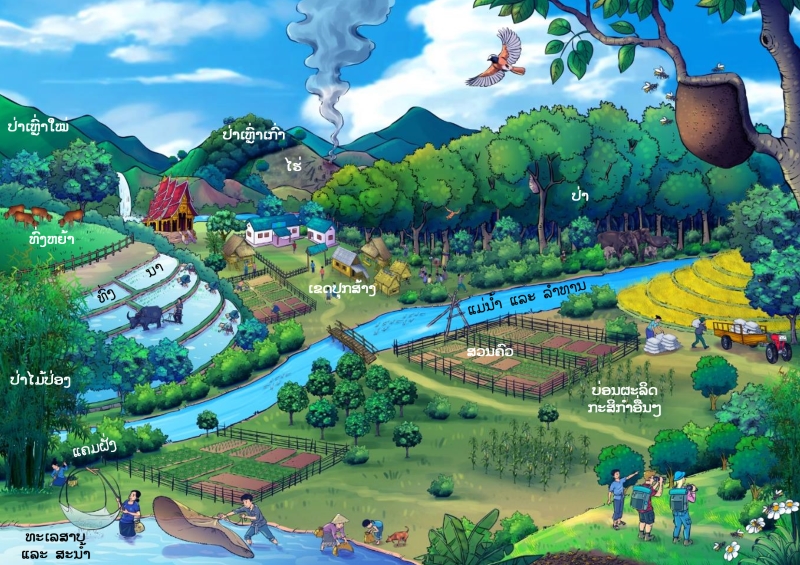
ສະເພາະຖິ່ນໃນລາວ:
ຕ່າງຖິ່ນ
ຮຸກຮານ
:
ບໍ່ຮຸກຮານ
ສະຖານະພາບການອະນູຮັກ IUCN
:
ບໍ່ມີຄວາມສ່ຽງ
ສະຖານະພາບການອະນຸຮັກແຫ່ງຊາດລາວ
:
ບໍ່ຖືກລະບຸໃນບັນຊີປະເພດໃດ
ການນຳໃຊ້
ປະເພດການນຳໃຊ້:
ກິດຈະກຳການກະເສດ
ອາຫານ
ພືດເປັນຢາ
ອາຫານ
ພືດເປັນຢາ
ບັນຍາຍການນຳໃຊ້:
ອາຫານ: ໂດຍທົ່ວໄປຫົວຈະຖືກນຳມາປຸ່ງສຸກ ໂດຍການນື້ງ, ທອດ, ຫຼື ຂົ້ວ, ໂດຍຈະນຳໄປອົບແຫ້ງ ຫຼື ດອກງ ໂດຍນຳມາປອກເປືອກ, ຕົ້ມ, ບົດ, ແລະ ອົບແຫ້ງເພື່ອຫຼຸດໄຊຍາໂນເຈນິກກຼູໂຄໄຊ cyanogenic glucosides). ມັນຕົ້ນເປັນແຫຼ່ງພະລັງງານທີ່ສຳຄັນ ເນື່ອງຈາກມີແປ້ງໃນປະລິມານສູງ. ໃບ ຫຼື ຍອດໃຊ້ຮັບກິນເປັນຜັກ, ໃນອາຊີຕາເວັນອອກສ່ຽງໃຕ້ ແລະ ລາຕິນອາເມລິກາ. ມັນຕົ້ນໃຊ້ເປັນອຸດສາຫະກຳເປັນຕົ້ນແມ່ນແປ້ງລາຄາຖືກ, ແປ້ງມັນຕົ້ນໃຊ້ເຮັດຄຸກກີ້, ເຂົ້າໜົມປັງ, ແພນເຄັກ, ໂດນັດ, ກ້ຽວ, ແລະ ເບີເກີ. [5]
ສະໝຸນໄພ: ຈາກການວິໄຈສະແດງໃຫ້ເຫັນວ່າມັນຕົ້ນ ມີສານໄຟໂຕເຄມີໂຄ (phytochemicals) ເຊິ່ງສາມາດຊ່ວຍຮັກສາພະຍາດຕ່າງໆໄດ້ ລວມທັງພະຍາດເບົາຫວານ, ພະແພພູມຄຸມກັນຕົວເອງ (celiac disease), ປັນຫາທາງກະດູກ ແລະ ລະບົບປະສາດ, ປັນຫາກ່ຽວກັບລະບົບຫຼອດເລືອດ ແລະ ຫົວໃຈ, ພະຍາດຕ່ອມລູກໝາກ, ພູມແພ້, ພະຍາດກ່ຽວກັບລະບົບທາງເດີນອາຫານ ແລະ ຄວາມດັນເລືອດ. [6]
ໃຊ້ໃນຟາມ: ໃບ, ກາກລຳຕົ້ນ ແລະ ຮາກສົດ ຫຼື ແຫ້ງ (ສັບ, ຊອຍ ຫຼື ບົດ) ເພື່ອເປັນອາຫານງົວນົມ ແລະ ສັດຄ້ຽວເອື້ອງທີ່ກິນຫຍ້າ. [5]
ໝາຍເຫດ: ສ່ວນຕ່າງໆຂອງພືດ ມີສານໄຮຍານີຄຼູໂຄໄຊນ໌ (hydrocyanic glucosides (HCN)) ເຊິ່ງເປັນພິດ, ແຕ່ສາມາດກຳຈັດໄດ້ດ້ວຍການປອກເປືອກ ແລະ ຕົ້ມໃຫ້ສຸກ. [5]
ສະໝຸນໄພ: ຈາກການວິໄຈສະແດງໃຫ້ເຫັນວ່າມັນຕົ້ນ ມີສານໄຟໂຕເຄມີໂຄ (phytochemicals) ເຊິ່ງສາມາດຊ່ວຍຮັກສາພະຍາດຕ່າງໆໄດ້ ລວມທັງພະຍາດເບົາຫວານ, ພະແພພູມຄຸມກັນຕົວເອງ (celiac disease), ປັນຫາທາງກະດູກ ແລະ ລະບົບປະສາດ, ປັນຫາກ່ຽວກັບລະບົບຫຼອດເລືອດ ແລະ ຫົວໃຈ, ພະຍາດຕ່ອມລູກໝາກ, ພູມແພ້, ພະຍາດກ່ຽວກັບລະບົບທາງເດີນອາຫານ ແລະ ຄວາມດັນເລືອດ. [6]
ໃຊ້ໃນຟາມ: ໃບ, ກາກລຳຕົ້ນ ແລະ ຮາກສົດ ຫຼື ແຫ້ງ (ສັບ, ຊອຍ ຫຼື ບົດ) ເພື່ອເປັນອາຫານງົວນົມ ແລະ ສັດຄ້ຽວເອື້ອງທີ່ກິນຫຍ້າ. [5]
ໝາຍເຫດ: ສ່ວນຕ່າງໆຂອງພືດ ມີສານໄຮຍານີຄຼູໂຄໄຊນ໌ (hydrocyanic glucosides (HCN)) ເຊິ່ງເປັນພິດ, ແຕ່ສາມາດກຳຈັດໄດ້ດ້ວຍການປອກເປືອກ ແລະ ຕົ້ມໃຫ້ສຸກ. [5]
ການປູກ ການລ້ຽງ:
ປູກ ແລະ ທຳມະຊາດ
ລະດູການເກັບກູ້:
ມັງກອນ
ກຸມພາ
ກັນຍາ
ຕຸລາ
ພະຈິກ
ທັນວາ
ກຸມພາ
ກັນຍາ
ຕຸລາ
ພະຈິກ
ທັນວາ
ການຕະຫຼາດ ແລະ ຕ່ອງໂສ້ມູນຄ່າ:
ລາຄາຂາຍມັນຕົ້ນດິບຢູ່ທີ່ 900 ຫາ 1,000 ກີບ ຕໍ່ກິໂລກຼາມ, ລາຄຄາຂາຍມັນຕົ້ນແຫ້ງຢູ່ທີ່ 3,000 ຫາ 4,500 ກີບ ຕໍ່ກິໂລກຼາມ. [12]
ການຄຸ້ມຄອງຈັດການ
ສະພາບໂດຍລວມ:
ອຸນຫະພູມ: ມັນຕົ້ນຈະເລີນເຕີບໂຕໄດ້ດີທີ່ສຸດ ໃນພື້ນທີ່ອຸ່ນຫະພູມສະເລ່ຍ 25 ຫາ 29 ອົງສາ ແລະ ອຸນຫະພູມດິນປະມານ 30 ອົງສາ, ແຕ່ຖ້າຕໍ່ຳກ່ວາ 10 ອົງສາ ມັນຕົ້ນຈະຢຸດການຈະເລີນເຕີບໂຕ. [7]
ປະລິມານນນ້ຳຝົນ: ມັນຕົ້ນຈະເລີນເຕີບໂຕໄດ້ດີທີ່ສຸດ ໃນປະລິມານນ້ຳຝົນຕະຫຼອດປີຢູ່ທີ່ 1,000 ຫາ 1,500 ແມັດກ້ອນ, ແຕ່ກໍ່ສາມາດທົນຕໍ່ສະພາບເຄິ່ງແຫ້ງແລ້ງ ທີ່ມີປະລິມານນ້ຳຝົນພຽງ 500 ແມັກກ້ອນ ແລະ ອາດມີຂໍ້ໄດ້ປຽບກ່ວາພືດຊະນິດອື່ນ ໃນສະພາບແວດລ້ອມເຫຼົ່ານີ້. [7]
ສະພາບດິນປູກ: ມັນຕົ້ນສາມາດເຕີບໂຕໄດ້ໃນດິນຫຼາຍປະເພດ ແຕ່ເໝາະທີ່ສຸດກັບດິນທີ່ມີຄວາມອຸດົມສົມບູນປານກາງ, ລະບາຍນ້ຳໄດ້ດີ, ມີເນື້ອສຳພັດເບົາ ແລະ ເລິກ, ພາຍໃຕ້ສະພາບຄວາອຸດົມສົມບູນສູງ ການຈະເລີນເຕີບໂຕຂອງສ່ວນເທິ່ງ. [7]
ການຄັດເລືອກສາຍພັນ:
Manihot esculenta subsp. esculenta
Manihot esculenta subsp. peruviana (Mull.Arg.) Allem
ການກຽມພື້ນທີ່:
ການກຽມດິນ: ກ້ຽມດິນໂດຍການໄຖ່ພວນດິນໃຫ້ເລິກປະມານ 20 ຫາ 30 ຊມ., ຫຼັງຈາກນັ້ນປະໄວ້ໃຫ້ເສດຊາກພືດເນ່າເປີອຍ ແລະ ຟູຂື້ນ, ຈາກນັ້ນ ໂດຍຕາກແດດໄວ້ປະມານ 7 ວັນ ແລ້ວໄຖ່ດິນຄືນອີກຄັ້ງເພື່ອປ້ອງກັນດິນເປັນກ່ອນແຂງ. [8]
ການກຽມສາຍພັນ: ຄວນເລືອກທ່ອນພັນມັນຕົ້ນເມື່ອອາຍຸ 8 ຫາ 18 ເດືອນ, ໂດຍຊ່ວງອາຍຸທີ່ເໝາະສົມທີ່ສຸດແມ່ນ 10 ຫາ 12 ເດືອນ. ທ່ອນພັນທີ່ມີຄຸນນະພາບສູງຕ້ອງມີຂະໜາດໃຫຍ່ ແລະ ແຂງແຮງ ໂດຍບໍ່ມີຂໍ້ ຫຼື ປ້ອງໃກ້ກັນ ຫຼື ຫ່າງກັນເກີນໄປ. [8]
ການເກັບຮັກສາແນວພັນມັນຕົ້ນ ໂດຍການມັດທອນມັນຕົ້ນລວມກັນປະມານ 20 ຕົ້ນ ແລະ ນຳມາຕັ້ງເປັນກຸ່ມລະ 5 ຫາ 6 ມັດ ໂດຍໃຫ້ແນ່ໃຈວ່າບໍ່ແໜ້ນເກີນໄປ ເພື່ອໃຫ້ມີອາກາດຖ່າຍເທໄດ້ດີ. ອີກວິທີໜຶ່ງຄືການປູກກິ່ງທ່ອນພັນໃນໜານ ເມື່ອພ້ອມຈະປູກໃຫ້ຕັດກິ່ງ ແລ້ວນຳໄປປູກທັນທີ. [8]
ກ່ອນປູກໃຫ້ຕັດເປັນທ່ອນຍາວປະມານ 20 ຫາ 25 ຊມ. ໂດຍໃຫ້ແຕ່ລະທ່ອນມີຕາ 5 ຫາ 7 ຕາ, ຄວນຕັດໃຫ້ພຽງ ຫຼື ລຽບ ແລະ ໃຊ້ດ້ານໂຄນຕົ້ນປັກລົງດິນໃຫ້ໄດ້ເຄິ່ງທ່ອນ. [8]
ເທັກນິກການປູກ:
ການປູກດ້ວຍແກ່ນ: ສ່ວນຫຼາຍຈະປູກດ້ວຍລຳຕົ້ນເປັນຫຼັກ, ແຕ່ຖ້າປູກດ້ວຍແກ່ນອັດຕາງອກຈະຕ່ຳກວ່າ 50%. ການປູກດ້ວຍແກ່ນຈະໃຊ້ສະເພາະການປູກເພື່ອຄັດເລືອກສານພັນໃຫ້ມີລັກສະນະຮາກນ້ອຍ. [5]
ການປູກດ້ວຍການປັກຊຳ: ຂັ້ນຕອນທຳອິດໃຫ້ຕັດກິ່ງອອກເປັນທ່ອນຍາວ 9 ຫາ 30 ຊມ., ໂດຍໃຫ້ແນ່ໃຈວ່ແຕ່ລະປ້ອງມີຂໍ້ ຫຼື ຕາໜຶ່ງອັນ, ຈັກນັ້ນໃຫ້ປັກທ່ອນລົງແນວຕັ້ງໃຫ້ເລິກປະມານ 8 ຫາ 15 ຊມ., ໃຊ້ທ່ອນພັນທີ່ມີຄວາມສົມບູນ ແລະ ບໍ່ມີແມງໄມ້ລົບກວນ. ໃນເຂດພື້ນທີ່ມີຄວາມສ່ຽງເກີດນ້ຳຄ້າງແຂງ, ການປູກແມ່ນຄວນໃຫ້ຜ່ານຊ່ວງອັນຍຕະລາຍໄປກ່ອນ. ເຮົາສາມາດປູກດ້ວຍວິທີການໃຊ້ມື ຫຼື ເຄຶ່ອງຈັກ.
ອຸນຫະພູມ: ມັນຕົ້ນຈະເລີນເຕີບໂຕໄດ້ດີທີ່ສຸດ ໃນພື້ນທີ່ອຸ່ນຫະພູມສະເລ່ຍ 25 ຫາ 29 ອົງສາ ແລະ ອຸນຫະພູມດິນປະມານ 30 ອົງສາ, ແຕ່ຖ້າຕໍ່ຳກ່ວາ 10 ອົງສາ ມັນຕົ້ນຈະຢຸດການຈະເລີນເຕີບໂຕ. [7]
ປະລິມານນນ້ຳຝົນ: ມັນຕົ້ນຈະເລີນເຕີບໂຕໄດ້ດີທີ່ສຸດ ໃນປະລິມານນ້ຳຝົນຕະຫຼອດປີຢູ່ທີ່ 1,000 ຫາ 1,500 ແມັດກ້ອນ, ແຕ່ກໍ່ສາມາດທົນຕໍ່ສະພາບເຄິ່ງແຫ້ງແລ້ງ ທີ່ມີປະລິມານນ້ຳຝົນພຽງ 500 ແມັກກ້ອນ ແລະ ອາດມີຂໍ້ໄດ້ປຽບກ່ວາພືດຊະນິດອື່ນ ໃນສະພາບແວດລ້ອມເຫຼົ່ານີ້. [7]
ສະພາບດິນປູກ: ມັນຕົ້ນສາມາດເຕີບໂຕໄດ້ໃນດິນຫຼາຍປະເພດ ແຕ່ເໝາະທີ່ສຸດກັບດິນທີ່ມີຄວາມອຸດົມສົມບູນປານກາງ, ລະບາຍນ້ຳໄດ້ດີ, ມີເນື້ອສຳພັດເບົາ ແລະ ເລິກ, ພາຍໃຕ້ສະພາບຄວາອຸດົມສົມບູນສູງ ການຈະເລີນເຕີບໂຕຂອງສ່ວນເທິ່ງ. [7]
ການຄັດເລືອກສາຍພັນ:
Manihot esculenta subsp. esculenta
Manihot esculenta subsp. peruviana (Mull.Arg.) Allem
ການກຽມພື້ນທີ່:
ການກຽມດິນ: ກ້ຽມດິນໂດຍການໄຖ່ພວນດິນໃຫ້ເລິກປະມານ 20 ຫາ 30 ຊມ., ຫຼັງຈາກນັ້ນປະໄວ້ໃຫ້ເສດຊາກພືດເນ່າເປີອຍ ແລະ ຟູຂື້ນ, ຈາກນັ້ນ ໂດຍຕາກແດດໄວ້ປະມານ 7 ວັນ ແລ້ວໄຖ່ດິນຄືນອີກຄັ້ງເພື່ອປ້ອງກັນດິນເປັນກ່ອນແຂງ. [8]
ການກຽມສາຍພັນ: ຄວນເລືອກທ່ອນພັນມັນຕົ້ນເມື່ອອາຍຸ 8 ຫາ 18 ເດືອນ, ໂດຍຊ່ວງອາຍຸທີ່ເໝາະສົມທີ່ສຸດແມ່ນ 10 ຫາ 12 ເດືອນ. ທ່ອນພັນທີ່ມີຄຸນນະພາບສູງຕ້ອງມີຂະໜາດໃຫຍ່ ແລະ ແຂງແຮງ ໂດຍບໍ່ມີຂໍ້ ຫຼື ປ້ອງໃກ້ກັນ ຫຼື ຫ່າງກັນເກີນໄປ. [8]
ການເກັບຮັກສາແນວພັນມັນຕົ້ນ ໂດຍການມັດທອນມັນຕົ້ນລວມກັນປະມານ 20 ຕົ້ນ ແລະ ນຳມາຕັ້ງເປັນກຸ່ມລະ 5 ຫາ 6 ມັດ ໂດຍໃຫ້ແນ່ໃຈວ່າບໍ່ແໜ້ນເກີນໄປ ເພື່ອໃຫ້ມີອາກາດຖ່າຍເທໄດ້ດີ. ອີກວິທີໜຶ່ງຄືການປູກກິ່ງທ່ອນພັນໃນໜານ ເມື່ອພ້ອມຈະປູກໃຫ້ຕັດກິ່ງ ແລ້ວນຳໄປປູກທັນທີ. [8]
ກ່ອນປູກໃຫ້ຕັດເປັນທ່ອນຍາວປະມານ 20 ຫາ 25 ຊມ. ໂດຍໃຫ້ແຕ່ລະທ່ອນມີຕາ 5 ຫາ 7 ຕາ, ຄວນຕັດໃຫ້ພຽງ ຫຼື ລຽບ ແລະ ໃຊ້ດ້ານໂຄນຕົ້ນປັກລົງດິນໃຫ້ໄດ້ເຄິ່ງທ່ອນ. [8]
ເທັກນິກການປູກ:
ການປູກດ້ວຍແກ່ນ: ສ່ວນຫຼາຍຈະປູກດ້ວຍລຳຕົ້ນເປັນຫຼັກ, ແຕ່ຖ້າປູກດ້ວຍແກ່ນອັດຕາງອກຈະຕ່ຳກວ່າ 50%. ການປູກດ້ວຍແກ່ນຈະໃຊ້ສະເພາະການປູກເພື່ອຄັດເລືອກສານພັນໃຫ້ມີລັກສະນະຮາກນ້ອຍ. [5]
ການປູກດ້ວຍການປັກຊຳ: ຂັ້ນຕອນທຳອິດໃຫ້ຕັດກິ່ງອອກເປັນທ່ອນຍາວ 9 ຫາ 30 ຊມ., ໂດຍໃຫ້ແນ່ໃຈວ່ແຕ່ລະປ້ອງມີຂໍ້ ຫຼື ຕາໜຶ່ງອັນ, ຈັກນັ້ນໃຫ້ປັກທ່ອນລົງແນວຕັ້ງໃຫ້ເລິກປະມານ 8 ຫາ 15 ຊມ., ໃຊ້ທ່ອນພັນທີ່ມີຄວາມສົມບູນ ແລະ ບໍ່ມີແມງໄມ້ລົບກວນ. ໃນເຂດພື້ນທີ່ມີຄວາມສ່ຽງເກີດນ້ຳຄ້າງແຂງ, ການປູກແມ່ນຄວນໃຫ້ຜ່ານຊ່ວງອັນຍຕະລາຍໄປກ່ອນ. ເຮົາສາມາດປູກດ້ວຍວິທີການໃຊ້ມື ຫຼື ເຄຶ່ອງຈັກ.
ໂພຊະນາການ
ຄຸນຄ່າທາງໂພຊະນາການ:
ແຫຼ່ງຄາໂບໄຮເດຣດທີ່ສຳຄັນ
ບັນຍາຍຄຸນຄ່າທາງໂພຊະນາການ:
ຮາກມັນຕົ້ນຖືໄດ້ວ່າເປັນແຫຼ່ງຜະລິດແປ້ງ ທີ່ສຳຄັນທີ່ສຸດຊະນິດໜຶ່ງຂອງໂລກ. [1]
| ສານອາຫານ | /100g | ໝາຍເຫດ |
|---|---|---|
| ໂປຣຕີນ | N/A | N/A |
| ຄາໂບໄຮເດຣດ | N/A | N/A |
| ໄຂມັນ | N/A | N/A |
| ວິຕາມິນ | N/A | N/A |
| ແຮ່ທາດ | N/A | N/A |
| ເສັ້ນໄຍ | N/A | N/A |
ອ້າງອິງ
ເຄດິດຮູບພາບ:
Leave and young shoot. [1] iNaturalist [Online]. Uploaded on 22 June 2024 by: Steve Collins. Available: https://www.inaturalist.org/observations/224324252. [Accessed: 21 January 2025]
Full Leave. [2] iNaturalist [Online]. Uploaded on 02 June 2022 by: Asentista, B.C. Available: https://www.inaturalist.org/observations/114613309. [Accessed: 21 January 2025]
Stem of cassava. [3] iNaturalist [Online]. Uploaded on 10 November 2020 by: tony2148. Available: https://www.inaturalist.org/observations/64590042. [Accessed: 21 January 2025]
Tuber of Cassava. [4] iNaturalist [Online]. Uploaded on 23 March 2024 by: educads. Available: https://www.inaturalist.org/observations/203585774. [Accessed: 21 January 2025]
Inflorescence and flower. [5] iNaturalist [Online]. Uploaded on 07 January 2023 by: shiaokao. Available: https://www.inaturalist.org/observations/146021769. [Accessed: 21 January 2025]
Fruits. [6] iNaturalist [Online]. Uploaded on 24 January 2021 by: Bryan Ramdeen. Available: https://www.inaturalist.org/observations/68535304. [Accessed: 21 January 2025]
Full Leave. [2] iNaturalist [Online]. Uploaded on 02 June 2022 by: Asentista, B.C. Available: https://www.inaturalist.org/observations/114613309. [Accessed: 21 January 2025]
Stem of cassava. [3] iNaturalist [Online]. Uploaded on 10 November 2020 by: tony2148. Available: https://www.inaturalist.org/observations/64590042. [Accessed: 21 January 2025]
Tuber of Cassava. [4] iNaturalist [Online]. Uploaded on 23 March 2024 by: educads. Available: https://www.inaturalist.org/observations/203585774. [Accessed: 21 January 2025]
Inflorescence and flower. [5] iNaturalist [Online]. Uploaded on 07 January 2023 by: shiaokao. Available: https://www.inaturalist.org/observations/146021769. [Accessed: 21 January 2025]
Fruits. [6] iNaturalist [Online]. Uploaded on 24 January 2021 by: Bryan Ramdeen. Available: https://www.inaturalist.org/observations/68535304. [Accessed: 21 January 2025]
ອ້າງອິງ:
[1] WFO, “The world flora online,” [Online]. Available: https://www.worldfloraonline.org/taxon/wfo-0000235507. [Ac-cessed: 04 July 2024].
[2] Global Biodiversity Information Facility (GBIF), “Manihot esculenta Crantz” [Online]. Available: https://www.gbif.org/species/3060998. [Accessed: 19 September 2024]
[3] IUCN Red List, “Manihot tristis,” [Online]. Available: https://www.iucnredlist.org/species/20755805/20756061. [Ac-cessed: 19 September 2024]
[4] ລັດທະມົນຕີກະຊວງກະຊິກຳແລະປ່າໄມ້, “ຂໍ້ຕົກລົງວ່າດ້ວຍ ການກຳນົດບັນຊີໄມ້ I, II ແລະ III,” ນະຄອນຫຼວງວຽງຈັນ: ກົມປ່າໄມ້, ກະຊວງກະຊິ ແລະ ກຳປ່າໄມ້, 2021.
[5] USDA NRCS National Plant Data Center, "Plant guide - CASSAVA," 2003.
[6] T. Z. Tsige, B. Basa, and T. Herago, "Medicinal, nutritional and anti-nutritional properties of cassava (Manihot esculenta): A review," American Journal of Nutrition, vol. 9, pp. 34-46, 2019.
[7] Food and Agriculture Organization (FAO), “Cassava production and environmental factors.” [Online]. Available: https://www.fao.org/4/y2413e/y2413e07.htm. [Accessed: 20 September 2024].
[8] "ຄູມືການຜະລິດມັນຕົ້ນ" ສູນຄົ້ນຄ້ວາກະຊິກຳເຂດຮ້ອນສາກົນ (CIAT), ສະາບັນຄົ້ນຄ້ວາກະຊິກຳ ແລະ ປ່າໄມ້ແຫ່ງຊາດ, [Online]. Available: https://research.aciar.gov.au/cassavavaluechains/wp-content/uploads/2019/04/Cassava-Production-Manual.pdfໃ [Ac-cessed: Sep. 10, 2024].
[9] World Flora Online, "Manihot esculenta Crantz," 2024. [Online]. Available: https://www.worldfloraonline.org/taxon/wfo-0000235507. [Accessed: Oct. 18, 2024].
[10] "Taxon Page for Flora of China," eFloras, 2024. [Online]. Available: http://www.efloras.org/florataxon.aspx?flora_id=2&taxon_id=200012596. [Accessed: Jan. 23, 2025].
[11] "Manihot esculenta Crantz," Kew Science, 2024. [Online]. Available: https://powo.science.kew.org/taxon/urn:lsid:ipni.org:names:351790-1. [Accessed: Jan. 23, 2025].
[12] L. Phattana, "Your tweet content here," X, Mar. 2023. [Online]. Avail-able: https://x.com/laophattana/status/1877197511259013515. [Ac-cessed: Jan. 23, 2025].
[2] Global Biodiversity Information Facility (GBIF), “Manihot esculenta Crantz” [Online]. Available: https://www.gbif.org/species/3060998. [Accessed: 19 September 2024]
[3] IUCN Red List, “Manihot tristis,” [Online]. Available: https://www.iucnredlist.org/species/20755805/20756061. [Ac-cessed: 19 September 2024]
[4] ລັດທະມົນຕີກະຊວງກະຊິກຳແລະປ່າໄມ້, “ຂໍ້ຕົກລົງວ່າດ້ວຍ ການກຳນົດບັນຊີໄມ້ I, II ແລະ III,” ນະຄອນຫຼວງວຽງຈັນ: ກົມປ່າໄມ້, ກະຊວງກະຊິ ແລະ ກຳປ່າໄມ້, 2021.
[5] USDA NRCS National Plant Data Center, "Plant guide - CASSAVA," 2003.
[6] T. Z. Tsige, B. Basa, and T. Herago, "Medicinal, nutritional and anti-nutritional properties of cassava (Manihot esculenta): A review," American Journal of Nutrition, vol. 9, pp. 34-46, 2019.
[7] Food and Agriculture Organization (FAO), “Cassava production and environmental factors.” [Online]. Available: https://www.fao.org/4/y2413e/y2413e07.htm. [Accessed: 20 September 2024].
[8] "ຄູມືການຜະລິດມັນຕົ້ນ" ສູນຄົ້ນຄ້ວາກະຊິກຳເຂດຮ້ອນສາກົນ (CIAT), ສະາບັນຄົ້ນຄ້ວາກະຊິກຳ ແລະ ປ່າໄມ້ແຫ່ງຊາດ, [Online]. Available: https://research.aciar.gov.au/cassavavaluechains/wp-content/uploads/2019/04/Cassava-Production-Manual.pdfໃ [Ac-cessed: Sep. 10, 2024].
[9] World Flora Online, "Manihot esculenta Crantz," 2024. [Online]. Available: https://www.worldfloraonline.org/taxon/wfo-0000235507. [Accessed: Oct. 18, 2024].
[10] "Taxon Page for Flora of China," eFloras, 2024. [Online]. Available: http://www.efloras.org/florataxon.aspx?flora_id=2&taxon_id=200012596. [Accessed: Jan. 23, 2025].
[11] "Manihot esculenta Crantz," Kew Science, 2024. [Online]. Available: https://powo.science.kew.org/taxon/urn:lsid:ipni.org:names:351790-1. [Accessed: Jan. 23, 2025].
[12] L. Phattana, "Your tweet content here," X, Mar. 2023. [Online]. Avail-able: https://x.com/laophattana/status/1877197511259013515. [Ac-cessed: Jan. 23, 2025].
ຜູ້ສ້າງ Factsheet:
ຜູ້ກວດສອບ Factsheet:
Daniela Barcelo, Biologists
